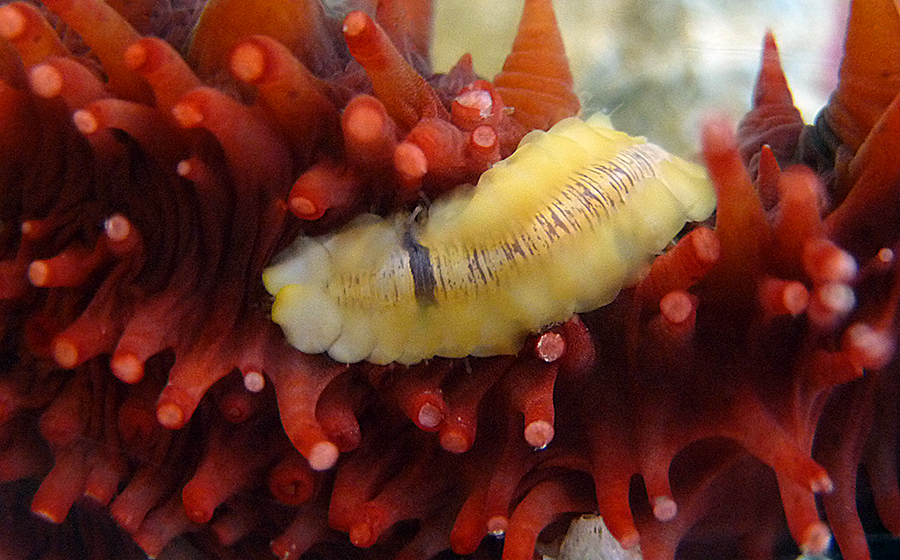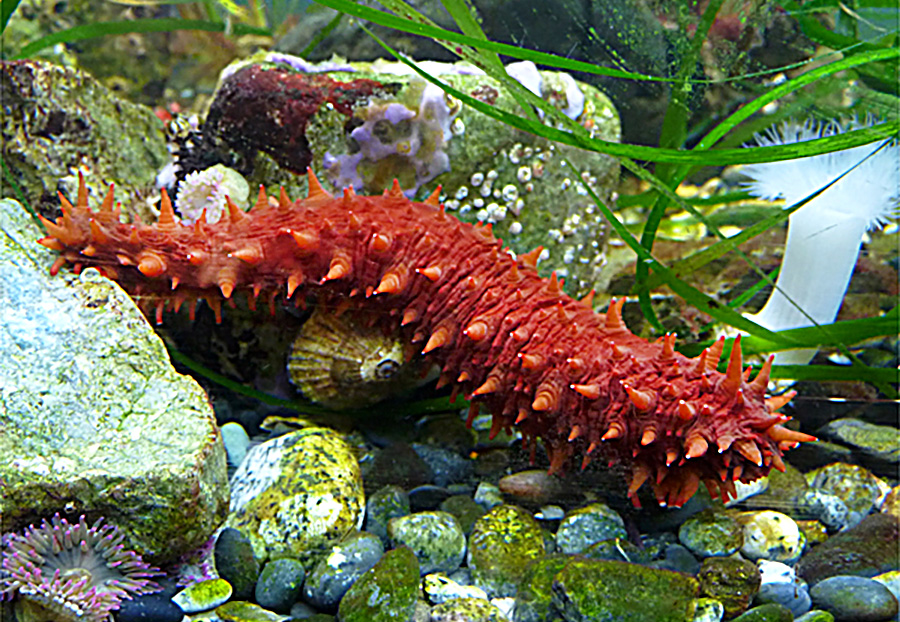California Sea Cucumber
Author: Colleen Maguire
Photos by Erin Pringle
Common Name: California Sea Cucumber, Giant Sea Cucumber, Giant Red Sea Cucumber
Scientific Name: Apostichopus californicus (formerly Parastichopus californicus)
Size Range: from 25- 40 cm in length (9.8- 15.7 inches)
Identifying Features: California Sea Cucumbers are generally reddish brown in colour but have many colour forms ranging from dark brown to white. All over its long fat body, there are soft, lighter coloured, cone shaped pseudospines that help it move across the ocean floor.

The commensal polychaete scale worm Arctonoe vittata hanging out on the California Sea Cucumber.
Habitat: The California Sea Cucumber lives in inter-tidal zones to 90 meters deep, in both exposed and sheltered areas. They can be found in these shallow waters from the Gulf of Alaska to Baja, California.
Food: The California Sea Cucumber eats tiny scrap particles of decaying matter or detritus, usually abundant in the areas they live. They have two different methods of feeding: direct deposit feeding, and suspension feeding. Direct deposit feeding is when the sea cucumbers drag their tentacles along the ocean floor to pick up food. Suspension feeding is when they use their fine, buccal tentacles to collect particles out of the water.
Predators: The Sunflower Star (Pycnopodia helianthoides) and the otter are both predators of the sea cucumber. As well, some parts of Asia harvest the California Sea Cucumber for the muscles along the inside of the body wall. To protect itself when confronted with extreme danger, the internal organs are ejected out of the anus, distracting predators with the sticky viscera. Also, they use their 5 long muscle bands to wriggle and writhe in order to try to escape from predators.
Life Cycle: When the California Sea Cucumber reaches maturity at approximately 4 years, they develop separate sexes. Some species lay many small eggs that are fertilized in the water by males and turn into larvae, while others produce large, yolk-filled eggs that hatch directly into cucumbers. Young cucumbers are lighter in colour, smaller and thinner, but they have regular sized conical papillae (or ‘spikes’).
References:
Bateman, Mat. (January 28, 2008). Sea Cucumbers. Scienceray. Retrieved June 9, 2010 from http://scienceray.com/biology/marine-biology/sea-cucumbers/
Duane Sept, J. (1999). The beachcomber’s guide to seashore life: In the Pacific Northwest. Madeira Park, British Columbia: Harbour Publishing.
Lamb, A & Hanby, B. (2005) Marine life of the Pacific Northwest: A photographic encyclopedia of invertebrates, seaweeds and selected fishes. Madeira Park, British Columbia: Harbour Publishing.

